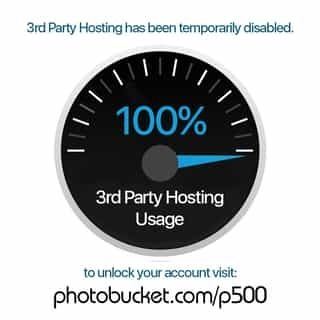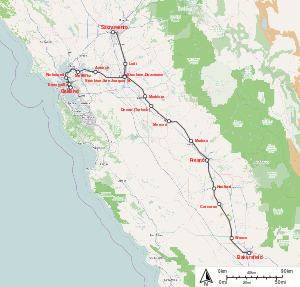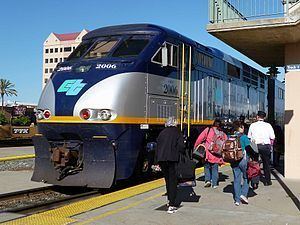Ridership 1177073 (FY15) First service 5 March 1974 Locale California | Start Bakersfield Service type Inter-city rail | |
 | ||
Predecessor Golden Gate, San Joaquin Daylight Current operator(s) Amtrak California, a partnership of Caltrans and Amtrak Website Amtrak Website
Amtrak California Website Stops 13 (Bakersfield–Oakland)
10 (Bakersfield–Sacramento) Distance travelled 315 miles (507 km) (Oakland)
282 miles (454 km) (Sacramento) Ends Oakland – Jack London Square, Sacramento Valley Station Track owners BNSF Railway, Union Pacific Railroad | ||
The San Joaquin (sometimes referred to as San Joaquins) is a passenger train operated by Amtrak, with funding from the California Department of Transportation as part of the Amtrak California network in California's Central Valley. Fourteen trains a day run between its southern terminus at Bakersfield and Stockton, where the route splits to Oakland (five trains each way per day) or Sacramento (two trains each way per day).
Contents
- Golden GateSan Joaquin Daylight
- Amtrak era
- Tehachapi Pass gap between Bakersfield and Los Angeles
- Rolling stock
- Locomotives
- California car bi level trainsets
- Comet car single level trainsets
- Route
- References

At Bakersfield, Thruway Motorcoach service offers connections to the Pacific Surfliner at Los Angeles Union Station, a number of points in Southern California, the High Desert (including Las Vegas, Nevada), and the Central Coast. Central Coast connections are also available at Hanford, California.

At Sacramento connections are available along a route ending in Reno, Nevada, or a route ending in Redding, California. The Martinez station offers connections along the Redwood Coast through Napa, California, as far north as McKinleyville. From Stockton, connecting routes are available to Redding and San Jose, with stops along the way. At Emeryville, Thruway Motorcoach service offers connections to San Francisco. Service is also available, through third-party contract, to Yosemite Valley, year-round from Merced and seasonally from Fresno.

The San Joaquin is Amtrak's fifth-busiest service and the railroad's third-busiest in California. During fiscal year 2013 (FY2013), the service carried a record 1.2 million passengers, a 6.6% increase from FY2012. Total revenue during FY2013 was US$39,401,591, a 1.9% increase over FY2012.

On July 1, 2015, management and governance of the San Joaquins passed to the San Joaquin Joint Powers Authority.

Golden Gate/San Joaquin Daylight

The San Joaquin runs over lines that once hosted several passenger trains a day. The top trains were the Golden Gate on the Atchison, Topeka and Santa Fe Railway (predecessor to BNSF), and the San Joaquin Daylight on the Southern Pacific Railroad (later acquired by Union Pacific). Prior to 1960s service cutbacks passenger service continued south of Bakersfield, to Glendale and Los Angeles.

In April 1965 as ridership on passenger trains continued to drop, the Santa Fe Railway received permission from the Interstate Commerce Commission to severely curtail Golden Gate operations, with service finally abandoned three years later. The San Joaquin Daylight was discontinued with the start-up of Amtrak in May 1971.
Other passenger trains that ran through the Central Valley included Southern Pacific's Owl and Santa Fe's San Francisco Chief and Valley Flyer.
Amtrak era
Amtrak routed all Los Angeles-San Francisco service over the Southern Pacific's Coast Line in its initial 1971 route structure, leaving the San Joaquin Valley without service. Both the Southern Pacific (San Joaquin Daylight) and the Santa Fe (San Francisco Chief) had served the region. Beginning in 1972 Amtrak revisited the decision at the urging of area congressmen, notably Bernice F. Sisk, who favored service between Oakland and Barstow or, failing that, Barstow and Sacramento. Service began on March 5, 1974 with one round-trip per day between Bakersfield and Oakland and a bus connection from Bakersfield to Los Angeles. Amtrak chose the Santa Fe route over the Southern Pacific, citing the higher speed (79 miles per hour (127 km/h) vs. 70 miles per hour (113 km/h)) of the Santa Fe and freight congestion on the Southern Pacific. The decision was not without controversy, with Sisk alleging that the Southern Pacific lobbied the Nixon Administration to influence the decision.
In 1979 Amtrak proposed discontinuing the San Joaquin as part of system-wide reductions ordered by the Carter Administration. The state of California stepped in to provide a yearly subsidy (then $700,000) to cover the train's operating losses, and it was retained. At the time the state asked Amtrak to add a second daily frequency between Oakland and Bakersfield, and to extend the service south over the Tehachapi Pass to Los Angeles. Amtrak added the second train in February 1980, but attempts to extend the train over the Tehachapi Loop failed due to Southern Pacific's opposition.
Tehachapi Pass gap between Bakersfield and Los Angeles
As of 2016 the San Joaquin does not continue south of Bakersfield because the only line between Bakersfield and points south, the Tehachapi Pass, is one of the world's busiest single-track freight rail lines.
Over the past 30 years service has increased from just one round trip per day to seven, five round trips to Oakland, plus two round trips to Sacramento.
Rolling stock
For its first two years of operation the San Joaquin used single-level coaches Amtrak had inherited from other railroads. In October 1976 Amtrak "Amfleeted" the San Joaquin, introducing new Amfleet coaches to the service. From 1987-1989 Amtrak used Superliner and ex-ATSF Hi-Level coaches. For a short period beginning on June 15, 1987, this included a full dining car on one of the trains. Amtrak requipped the San Joaquin trains again in 1989, this time with new Horizon coaches, when service expanded to three daily round-trips. The San Joaquin began receiving the Superliner-derived "California Cars" that it uses today in 1995.
Locomotives
Amtrak California operates its own fleet of EMD F59PHI and GE P32-8WH locomotives that are used on San Joaquin trains. These locomotives are owned by Caltrans and carry its CDTX reporting marks. Amtrak owned locomotives are also occasionally used on the San Joaquin, including the P42DC.
"California car" bi-level trainsets
The San Joaquin is equipped with Amtrak California's fleet of "California Car" bi-level, high-capacity passenger cars owned by the California Department of Transportation (Caltrans). Each trainset typically consists of two coach cars, a coach/baggage car, a café (dining) car, and a cab/coach car. The cab/coach car is a similar to other coaches but with an engineer's operating cab and headlights on one end, allowing the train to be operated in push-pull mode, which eliminates the need to turn the train at each end-point. Caltrans is in the process of refitting the cab/coach cars to have a space on car's lower level for storage for checked luggage and bikes.
Caltrans also owns several Surfliner bi-level cars that are used on some San Joaquin trainsets. The newer cars look very similar to the California Car fleet, but feature reclining seats, open overhead luggage racks and a restroom on the upper-level of each car.
In 2007 Caltrans paid to repair several wreck-damaged Superliner I coaches in exchange for a six-year lease of the Amtrak owned cars that are normally used on long-distance trains. Four of these cars are painted to match the "California car" livery and often appear in service on the San Joaquin route in place of a coach/baggage car.
"Comet car" single-level trainsets
Increasing ridership on the San Joaquin led Caltrans to purchase 14 Comet IB rail cars from New Jersey Transit in 2008 for $75,000 per car. The former commuter cars refurbished and reconfigured by Amtrak's Beech Grove Shops to serve as intercity coaches at a cost of approximately $20 million. The refurbished cars have reclining inter-city seats with tray tables (4 per row), AmtrakConnect WiFi, two power outlets at each seat pair, luggage racks, trash/recycling bins, a restroom, and 6 workstation tables in the center of the car.
Caltrans has also paid to lease and refurbish 3 Non-Powered Control Units (F40PH locomotives converted into cab/baggage cars) and 3 Horizon Dinettes to serve as café cars (using the same equipment as other Amtrak California trains).
These single-level cars will be used to create two "Comet car" trainsets that will run between Oakland and Bakersfield. That will allow Caltrans to break up two bi-level "California car" trainsets to use the cars to add another coach car to each of the San Joaquin's remaining "California Car" trainsets.
Caltrans had planned to use the "Comet car" trainsets on trains starting in July 2013, but the refurbishing process took longer than expected. The first "Comet car" trainset was put into regular service on October 21, 2013 and the second trainset was put into regular service on April 15, 2014.
Route
The San Joaquin runs from Bakersfield's Truxtun Avenue Station northward on BNSF Railway's Mojave Subdivision within Bakersfield, the Bakersfield Subdivision from Bakersfield to Calwa (Fresno), then on the Stockton Subdivision from Calwa to Stockton.
At Stockton the routes split to Oakland or Sacramento:
